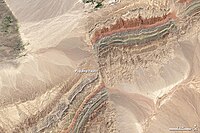
Photo from wikipedia
High-resolution seismic reflection, magnetic and gravity data, acquired offshore of Etna volcano, provide a new insight to understanding the relationship between tectonics and spatial-temporal evolution of volcanism. The Timpe Plateau,… Click to show full abstract
High-resolution seismic reflection, magnetic and gravity data, acquired offshore of Etna volcano, provide a new insight to understanding the relationship between tectonics and spatial-temporal evolution of volcanism. The Timpe Plateau, a structural high pertaining to the Hyblean foreland domain, located offshore of southeastern Mt. Etna, is speckled by volcanics and strongly affected by strike-slip tectonics. Transpressive deformation produced a push-up and a remarkable shortening along WNW-ESE to NW-SE trending lineaments. Fault segments, bounding basinal areas, show evidence of positive tectonic inversion, suggesting a former transtensive phase. Transtensive tectonics favoured the emplacement of deep magmatic intrusive bodies and Plio-Quaternary scattered volcanics through releasing zones. The continuing of wrench tectonics along different shear zones led to the migration of transtensive regions in the Etna area and the positive inversion of the former ones, where new magma ascent was hampered. This process caused the shifting of volcanism firstly along the main WNW-ESE trending “Southern Etna Shear Zone”, then towards the Valle del Bove and finally up to the present-day stratovolcano.
Journal Title: Scientific Reports
Year Published: 2019
Link to full text (if available)
Share on Social Media: Sign Up to like & get
recommendations!